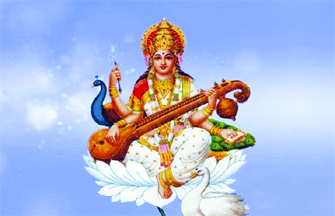
The Indian festival of Basant Panchami, also known as Saraswati Puja, marks the beginning of the spring festival. The festival typically takes place between the end of January and the beginning of February. This year, Basant Panchami falls on Wednesday, February 14.
According to legend, Kalidasa had intended to commit suicide by drowning himself in a river after learning that his wife had been abandoned. Goddess Saraswati asked Kalidasa to take a bath in the water as she emerged from the water just as he was about to do that. After that, his life changed as he was endowed with wisdom and rose to become a great poet.
According to mythology, Kamadeva once interrupted Lord Shiva’s meditation while he was immersed in it after the death of his wife Sati. This story is based on the Hindu god of love Kama. So that Shiva could re-establish contact with the outside world and become aware of Maa Parvati’s efforts on his behalf, seers approached Kama to rouse him from his meditation.
Kama agreed and used his sugarcane bow to launch arrows at Shiva which was made of flowers and bees. Kama was reduced to ashes by Lord Shiva after opening his third eye in rage. After Rati (his wife) completed her 40-day penance, Shiva agreed to resurrect him on Basant Panchami. He allegedly later gave birth to the son of Lord Krishna named Pradumna.
BIRTHDAY OF GODDESS SARASWATI
Basant Panchami is also denoted as Saraswati Puja by the Hindus in India. It is believed that on this day, Goddess Saraswati, the goddess of art, crafts and knowledge was born. She conferred upon humanity the greatest wealth that a human being can ever ask for, the gift of Knowledge. The Hindu mythology popularizes Goddess Saraswati as the immaculate power who bestows upon the worthy with the wealth of knowledge. The color white is associated with the goddess of knowledge as it is the symbol of peace and serenity. Images of goddess Saraswati with white adornments, sitting on a white lotus flower which blooms in a wide stretch of water are quite commonly seen on this day. Goddess Saraswati or Maa Saraswati, as called by the people of West Bengal, is worshipped on this auspicious day by the worshippers who are themselves clad in the color yellow, the color of spring. Prasad is offered to the goddess and later the same is distributed among the worshippers. The popular festival is related to the goddess of knowledge; hence, children are initiated towards learning and gaining knowledge.
This is significant because it is the birth day of goddess Saraswati. As the river Saraswati is associated with the goddess, rituals are performed on the banks of this holy river. Offerings are made but no sacrifices are conducted. Vegetarian food is cooked and had on this day and people abstain from non-vegetarian food. Goddess Saraswati is supposed to be the goddess of art, literature and speech too; hence, hymns are written and sung in praise of the goddess on Basant Panchami. Whenever a new teaching institution is started, goddess Saraswati is worshipped. A school is considered to be the temple of learning and hence, a temple of the goddess itself. Schools and colleges organize special functions and cultural activities on this particular day and devote these to goddess Saraswati. Students offer a lot of flowers to the image of Saraswati. They keep all their study materials like books, articles, instruments of music and arts, earthen inkpots and bamboo quills in front of the deity. No one reads anything on this day; it is a way to show their reverence to the deity of knowledge. Most Hindu communities celebrate this festival with great pomp and show as this is the time of the year when goddess Saraswati is remembered by its followers.
Significance
This day falls on the fifth day of the Hindu month of Magh, which is also the first day of spring. Goddess Saraswati denotes serenity and calmness. She is generally shown seated on a white lotus, wearing a pure white silk sari and holding a book in her lower left hand. The eyes of the goddess are full of compassion. Her four hands denote four facets of human personality namely mind, intellect, alertness and ego. The lotus on her hand symbolizes true knowledge. Her ride is a white swan which is known for its peculiar capability of separating water from the milk. The swan indicates that we should have the ability to discriminate the bad from the good.
Basant Panchami, also known as the Saraswati Day, is celebrated by the Hindus across the world with great enthusiasm and festivities. The devotees visit temples which are filled with various types of religious activities. Yellow color is given prominence on this day and people dress up in yellow garments and perform rituals. Yellow represents spiritual knowledge, increasing the significance of the festival. People eat yellow sweets and distribute the same among friends and relatives. People feed Brahmans on this occasion and also perform Pitra- Tarpan, the traditional ancestral worship.
Basant Panchami is the day when children are taught their first words, making it an auspicious occasion which marks the beginning of their learning process. On this day, schools and colleges organize special worships for goddess Saraswati. Traditionally children place their books on the altar, at the goddess’s feet. No one is allowed to touch the books during this period as they believe that goddess Saraswati is blessing the books. Devotees believe that worshipping of goddess Saraswati will lead to spiritual enlightenment. It is generally said that there is no comparison between a king and a learned person as the king is honored only in his land but a learned person is respected everywhere.
Saintly and learned people who are inclined towards spirituality know the importance of worshipping goddess Saraswati. Other activities performed on this day include worshipping of Kamadeva, the God of Love. On this occasion, people offers prayers to the Sun God and the deities associated with Ganges. The festivities of Basant Panchami include kite flying and a kite festival is observed in Ferozepur, Punjab. Basant Panchami marks the arrival of spring and can be noted from the colored blooms in trees and crops. This is the period when mango flowers start blossoming on trees, representing the beginning of a new life. Basant Panchami spiritually signifies that the days of ignorance and gloom are over and the period of joy and spiritual awakening has begun.
Kite Festival
The festival of Basant Panchami is celebrated to welcome the season of spring, a season when the earth replenishes itself. Spring also denotes pleasant weather, during which calm wind whistles in your ear and caresses your face with its light cool touch. It is the season when the weather is neither hot nor cold, when the wind has a cooling effect but not the kind to chill your bones. This kind of weather reminds you of a number of things including Basant Panchami, the primary festival of this season. It is one of the most colorful and wonderful festivals of this effervescent nation and is celebrated on the fifth day of the Indian month of Magh. The festival brings in a number of colors in the form of colorful attires.





Be the first to comment